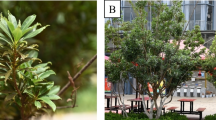Abstract
The tertiary structure of nucleic acid hairpins was elucidated by means of the accessibility of the single-strand-specific nuclease from mung bean. This molecular probe has proven especially useful in determining details of the structural arrangement of the nucleotides within a loop. In this study 3'-labeling is introduced to complement previously used 5'-labeling in order to assess and to exclude possible artifacts of the method. Both labeling procedures result in mutually consistent cleavage patterns. Therefore, methodological artifacts can be excluded and the potential of the nuclease as structural probe is increased. DNA hairpins with five and six membered loops reveal an asymmetric loop structure with a sharp bend of the phosphate-ribose backbone between the second and third nucleotide on the 3'-side of a loop. These hairpin structures differ from smaller loops with 3 or 4 members, which reveal this type of bend between the first and second 3' nucleotide, and resemble with respect to the asymmetry anticodon loops of tRNA.
Similar content being viewed by others
Abbreviations
- The hairpin oligonucleotides are indicated by hp:
-
hairpin followed by the loop sequence, starting at the 5'-end, in parenthesis; d for deoxy is omitted for clarity
References
Lilley DMJ (1982) in Neidle S [Ed] Topics in nucleic acid structure, vol. 2 (pp. 173–198) Mcmillan, London
Kuhn H & Waser J (1981) Angew. Chem., Int. Ed. Engl. 20: 500–520
van de Ven FJM & Hilbers CW (1988) Eur. J. Biochem. 178: 1–38
Gralla J & Crothers DM (1973) J. Mol. Biol. 73: 497–511
Haasnoot CAG, de Bruin SH, Berendsen RG, Janssen HGJM, Binnendijk TJJ, Hilbers CW, van der Marel GA & van Boom JH (1983) J. Biomol. Struct. Dyn. I: 115–129
Uhlenbeck OC, Borer PN, Dengler B & Tinoco I Jr (1973) J. Mol. Biol. 73: 483–496
Baumann U, Frank R & Blöcker H (1986) Eur. J. Biochem. 161: 409–413
Xodo LE, Manzini G, Quadrifoglio F, van der Marel G & van Boom JH (1991) Nucl. Acids Res. 19: 1505–1511
Kinjo M, Hasegawa T, Nagano K, Ishikura H & Ishigami M (1986) J. Mol. Evol. 23: 320–327
Drew HR (1984) J. Mol. Biol. 176: 535–557
Vournakis JN, Celantano J, Finn M, Lockard RE, Mitra T, Pavlakis G, Troutt A, van den Berg M & Wurst RM (1981) in Chirikjian JG & Papas TS [Eds] Gene amplification and analysis, vol. 2 (pp. 267–298) Elsevier North Holland, New York
Göringer H-U, Szymkowiak C & Wagner R (1984) Eur. J. Biochem. 144: 25–34
Wells RD et al. (1977) Crit. Rev. Biochem. 4: 305–340
Bacolla A & Wu FY-H (1991) Nucl. Acids Res. 19: 1639–1647
Szafranski P & Godson GN (1990) Gene 88: 141–147
Laskowski Sr M (1980) Methods Enzymol. 65: 263–275
Green MR & Roeder RG (1980) Cell 22: 231–242
Baumann U, Fischer W & Spinzl M (1985) Eur. J. Biochem. 152: 645–649
Sundquist WI & Klug A (1989) Nature 342: 825–829
Rich A & RajBhandary UL (1976) Ann. Rev. Biochem. 45: 805–860
Moras D, Comarmond MB, Fischer J, Weiss R, Thierry JC, Ebel JP & Giege R (1980) Nature 288: 669–674
Wrede P, Woo NH & Rich A (1979) Proc. Natl Acad. Sci. 76: 3289–3293
Baumann U, Lehmann U, Schwellnus K, van Boom JH & Kuhn H (1987) Eur. J. Biochem. 170: 267–272
Haasnoot CAG, Hilbers CW, van der Marel GA, van Boom JH, Singh UC, Pattabiranam N & Kollman PA (1986) J. Biomol. Struct. Dyn. 3: 843–857
Blommers, MJJ, van de Ven FJM, van der Marel GA, van Boom JH & Hilbers CW (1991) Eur. J. Biochem. 201: 33–51
Senior MM, Jones RA & Breslauer KJ (1988) Proc. Natl Acad. Sci. 85: 6242–6246
Author information
Authors and Affiliations
Rights and permissions
About this article
Cite this article
Baumann, U., Chang, S. Asymmetric structure of five and six membered DNA hairpin loops. Mol Biol Rep 22, 25–31 (1995). https://doi.org/10.1007/BF00996301
Received:
Accepted:
Issue Date:
DOI: https://doi.org/10.1007/BF00996301




